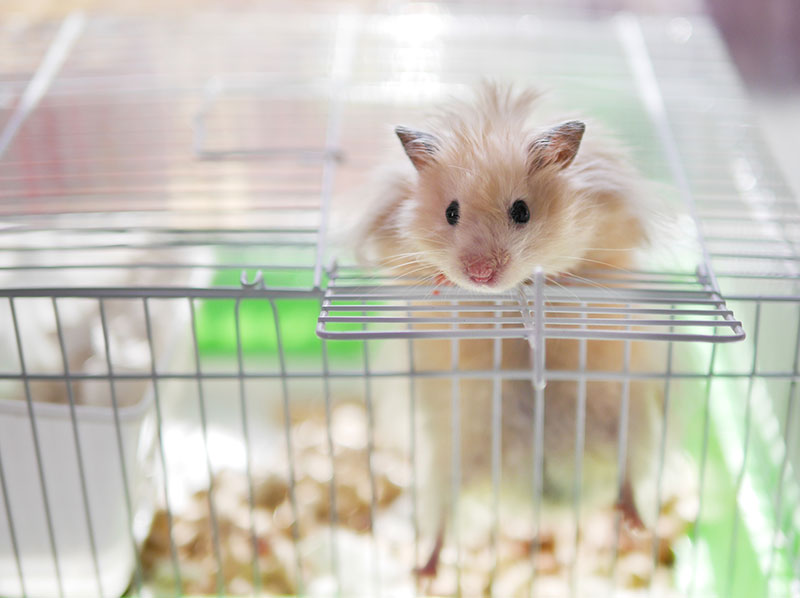Hamsters are relatively easy pets to care for, but we frequently get asked the question: “why is my hamster always trying to escape?” When your hamster is constantly looking for a way out, it’s easy to feel like they’re upset or that you’re an inadequate pet owner.
Hamsters try to escape their cage because they desire to explore their environment and stimulate their minds. Your hamster may be bored and require more stimulation from toys or its small environment. Additionally, a small or dirty cage may prompt your hamster to try to “escape” more often.
Below, we will discuss why hamsters try to escape their cages and the normalcy of this behavior. Additionally, we will talk about some strategies for keeping your hamster from escaping or attempting to escape. Usually, the answer is adding more stimulation or considering a larger cage for your pet.
Table of Contents
Why Is My Hamster Trying To Escape?
The word escape indicates a desire to get away from something negative. In fact, though the definition is simply “break free from confinement or control”, we usually associate the word with prisoners escaping jail or victims escaping their captor. So when we see our hamster trying to get out of their cage, we may be self-conscious and worried about their attempted “escape”.
Hamsters will usually try to escape their cage if they want to explore more of their environment or if they’re bored. If their cage is too small or doesn’t provide enough food or water, they may want to look for extra resources. A dirty cage may prompt your hamster to look for other homes.
If you are giving your hamster enough food and water, and the cage is pretty clean, you can assume your hamster is just trying to explore. This could be out of boredom or curiosity.
An escaping hamster might also indicate they’re not a big fan of their home, which can be fixed by experimenting with different bedding or making sure there’s enough furniture inside their cage.
Additionally, escaping can be a way for your hamster to communicate to you something that isn’t to their liking. If you have the time, you can observe your hamster and see what triggers their escaping behavior. You might notice that your kids crowding it or the cat being near prompt your hamster to try and get out of its cage.
If this is the case, it’s likely your hamster is using a survival mechanism. You can provide more hiding spots or keep kids and cats away.

Is It Normal For A Hamster To Try To Escape?
Seeing your hamster trying to squeeze its fluffy little body in between the slots in its cage might raise some red flags (or at least eyebrows). Is it normal for hamsters to do this?
It is normal for hamsters to try to escape their cages every so often. It just means they might not be happy with their environment. Hamsters are unable to communicate in the same ways cats and dogs are, so this might be their way of telling you they lack a resource or need more stimulation.
Most hamster owners will tell you that their hamster has tried to escape at one point or another. Your hamster isn’t abnormal, and you aren’t a bad owner because this behavior is showing up.
If the escaping behavior is paired with other ominous signs, such as your hamster not eating or drinking, acting aggressively, or hiding most of the time, this might be a sign something more is going on. However, escaping on its own doesn’t mean anything is wrong with your hamster.
If My Hamster Tries to Escape Does This Mean They Are Unhappy?
Hamsters can feel emotion and have preferences, even though they’re small and often hard-to-read creatures. Again, the word “escape” might make us feel like the captor, and our furry pets are the villain. But this isn’t the case.
If your hamster tries to escape, this doesn’t mean they are unhappy. They are most likely looking for a way to stimulate their minds or explore their environment. In this instance, they may not be comfortable or their cage might be too small.
At the worst, your hamster may just be communicating to you that something is triggering them or making them feel scared. As mentioned above, observing what makes your hamster engage in this behavior might give you some insight.

Just as humans enjoy hiking, visiting new places, and seeing new things, hamsters may be curious about the world around them. Additionally, messing with the door or the spaces between the grates of a cage may be stimulating your hamster.
It’s much more likely that your hamster feels bored than unhappy if they’re displaying escaping behaviors. Below, we talk about ways to keep your hamster stimulated and happy.
How do I Stop My Hamster From Trying to Escape?
If you researched your cage thoroughly and are sure your hamster won’t get out, you still might want some alternative solutions for peace of mind. Regardless of how sure you are that your hamster won’t go anywhere, it’s not ideal for them to constantly try and fail at an adventure. There are a few ways you can get your hamster to stop trying to escape from its cage.
You can stop your hamster from trying to escape by stimulating them mentally and making sure they have an adequate-sized cage. Toys, climbers, and teethers are great ways to keep your hamster occupied. Additionally, a large cage will give them more space to explore.
You can train your hamster to seek other options when they are thinking of escaping. For training purposes, with children and other bigger pets like dogs, it’s essential to provide replacement behaviors for the behaviors we don’t like to see.
For example, research shows that when children are engaging in an undesired behavior (like hitting), we need to teach them a way to get what they want without the behavior (such as tapping a friend on the shoulder and saying, “can I have a turn?”). The same principles can be applied to your hamster. When your hamster is trying to escape, draw their attention to a different activity within their cage.
If you aren’t sure how to get your hamster to feel less bored, toys or hamster wheels are an excellent place to start. Hamster tubes are also an excellent stimulant for bored hamsters and can help your hamster feel like more of an explorer from within its cage.
Additionally, taking your hamster out of their cage for some love and attention never goes amiss. Giving them the chance to engage with you will help keep them happy and healthy.
Conclusion
Hamsters commonly try to “escape” their cages because they want to explore or have something to do. If you find your hamster trying to escape its cage, try not to make it a reflection of what kind of pet owner you are.
It’s natural to jump to thinking your pet dislikes you and wants to get away, but this isn’t the case. Sometimes the hamster may be looking for more water or food or a cleaner environment to live in, so make sure your hamster has everything it needs before jumping to conclusions.






